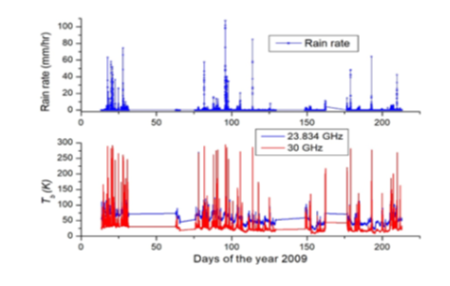


Indian Journal of Science and Technology
Year: 2021, Volume: 14, Issue: 27, Pages: 2250-2256
Original Article
Manabendra Maiti1, Kausik Bhattacharyya2, Salil Kumar Biswas3, Md Anoarul Islam1, Ayan Pradhan4, Judhajit Sanyal1*
1Department of Electronics & Communication Engineering, Techno International New Town, Kolkata, 700156, West Bengal, India
2Department of Physics, Tamralipta Mahavidyalaya, Tamluk, East Medinipur, 721636, West
Bengal, India
3Department of Physics, University of Calcutta, 92 A.P.C Road Kolkata, 700009, West Bengal,
India
4Department of Electronics, Acharya Prafulla Chandra College, New Barrackpore, Kolkata,
700131, West Bengal, India
*Corresponding Author
Email: [email protected]
Received Date:17 March 2021, Accepted Date:19 July 2021, Published Date:04 August 2021
Objectives: To predict meteorological phenomena such as rain events from sky status during rainy and non-rainy periods. Methods: The method used here is based on brightness temperature ratio measurement at two different frequencies, namely 23.8 GHz and 30 GHz respectively, using ground based dual frequency radiometric data. The ratios of brightness temperature readings obtained by the dual-frequency radiometer at the two above mentioned frequencies are calculated for each simultaneously-taken pair of measurements. Data obtained by the authors for the year 2009 at Cachoeira Paulista in Brazil has been used for analysis. Findings: The major results obtained from the analysis of data collected over a continuous period of seven months are used to construct corresponding histograms and cumulative count graphs of brightness temperature ratios. The histograms and graphs clearly show three peak values that could be interpreted as thresholds between clear sky, cloudy sky and rainy sky conditions respectively. Novelty: The study implements detection of rain events from sky status during rainy and non-rainy periods using peak brightness temperature values obtained from graphs generated using the observation data. The outlined technique can therefore be used to clearly determine sky conditions and accurately predict rain phenomena. The ratio of brightness temperatures at the two frequencies is a unique parameter which is critical to the successful estimation of rain from sky status. The results agree well with multi-channel radiometric data obtained by other researchers at lower frequencies.
Keywords: sky status; microwave; millimeter wave; dual frequency radiometer; brightness temperature; rainfall
© 2021 Maiti et al. This is an open-access article distributed under the terms of the Creative Commons Attribution License, which permits unrestricted use, distribution, and reproduction in any medium, provided the original author and source are credited. Published By Indian Society for Education and Environment (iSee)
Subscribe now for latest articles and news.